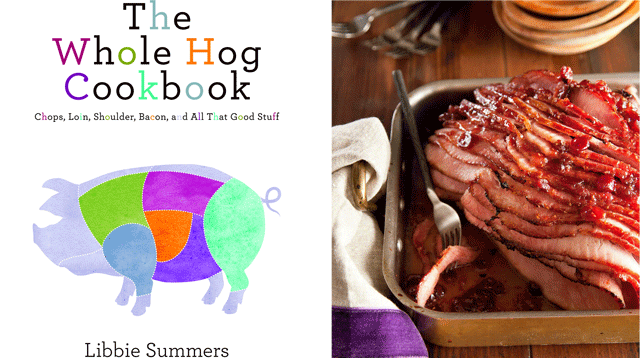Libbie Summers says they always had a turkey for Thanksgiving and they always had a ham.
“Turkey was about the holiday. Ham was about feeding a lot of people,” says the author of the new The Whole Hog Cookbook (Rizzoli).
For Thanksgiving she suggests a simple fresh ham recipe, which is just one 15-pound leg, one cup of tamari soy sauce and nothing else. “When meat’s that’s good, you don’t need much,” she says.
Or try Red-Hot Summer Berry Glazed Ham basted with a raspberry, strawberry, cranberry, honey and chipotle sauce. Pâté No. 7, pork and chicken livers with Jack Daniels is a terrific appetizer, she says, as is Bacon Beignets.
She learned her place in the food chain at grandmother Lula Mae Gibson’s hog farm in Moberly, Missouri when she tried to ride one of Lula Mae’s prized Yorkshire pigs. Appalled, grandma softly and swiftly swatted Summers on the rump.
Nothing says Thanksgiving like the sweet-smelling aroma of a Thanksgiving dinner. From plump and juicy turkeys to delectable desserts, send us photos and videos of your Thanksgiving meals.
“Pigs were everything to Lula Mae,” she explains. Obviously it’s in the genes because they’re everything to Summers, too. The Whole Hog Cookbook (Rizzoli) is Summers’ ode to pig and the versatility of pork.
Pork for her is not the other white meat, it’s the “approachable meat.” She divvies up the chapters by divvying up the pig, naming chapters for retail cuts, i.e. loin, shoulder, followed by recipes for that cut.
“Even if you’re not the greatest cook,” she says, “you can make something good with any cut of pork. Pork’s that good.”
Heritage breeds, breeds popular before WWII, are the tastiest. Found at farmers markets and on-line, they roam pastures like their pre-war counterparts, getting plenty of exercise and fresh air, leading happy piggy lives until the inevitable. Varied diets and higher fat content make for better flavor. Consumer demand forced large-scale farms to breed pigs with less fat. That, along with no exercise and a narrow diet flattened industrial pork’s flavor.
Berkshires, the most popular Heritage breed and the one you’re most likely to see on menus, start out as black pigs with white legs, says Summers, and end up as sweet, nutty meat. Jowly Red Wattles are lean and juicy with a beefy taste. Irish Tamworth make the best bacon and Ossabaw Island make great charcuterie—ham, sausages, pâtés. Large Black produce moist meat and make excellent bacon. Rare Magalitsas are called the Waygu of pork, a nod to Japan’s expensive, highly-marbled beef. Magalitsas, have twice the marbling of other breeds.
Supermarkets are slowly introducing breeds and cuts—Summers gets pork-belly at her local Piggly Wiggly in Savannah. If you can’t get Heritage-bred pork Summers suggests Smithfield Hams (she’s consulted for them), purveyors of pork for seventy-five years.
Pigs, she says, were never pets. “You don’t name a pig that’s going to slaughter. That’s what you eat.” You sustained the animal and the animal sustained you. Her grandmother used absolutely everything (Summers jumped rope with pig intestine) and the book reflects that snout-to-tail utility. She enjoys taking unfamiliar cuts and showing what treasures they yield.
Take leaf lard.
When rendered, “leaf” fat from around the kidneys and loin produces leaf lard, the highest grade of lard with little to no pork flavor. (Render your own with leaf fat from the butcher or get leaf lard on-line.) Leaf lard is the secret to incredible crusts, she says.
“My pie dough will change the world,” she laughs. Vanilla sugar, salt, cold butter, cold leaf lard and ice-cold water, “make the best pie you’ll ever eat.” It’s the secret to her Sweet Potato Pork Pie, ground pork, onions, sweet potatoes, applesauce, cinnamon and cloves. No matter how good the filling, if the crust isn’t good, the pie’s not good.
Summers has easy recipes, like the ham and more involved ones like pâté. Then there are her “gateway” recipes. They’re recipes that look harder than they are, like Breakfast Sausage and Wet-Cure Bacon. Trying them and seeing how quickly you can actually master them can be a game-changer. “Once you learn something you’re proud of,” says Summers, “you’re like a pastor in a pulpit.”
The FDA recommends cooking pork to an internal temperature of 145-degrees, down from a 160-degrees, resulting in juicier meat with a little pink tinge. “It’ll change your relationship with pork,” she says. “You’ll become closer.”
“Bacon tastes gooood. Pork chops tastes gooood,” says Vincent Vega, John Travolta’s Pulp Fiction character, sounding a whole lot like Libbie Summers.
“Add ham to anything, it’s gonna taste good,” she says. “Add bacon to anything and it’s gonna taste better. Nothing with bacon thrown in can ever be bad.”

